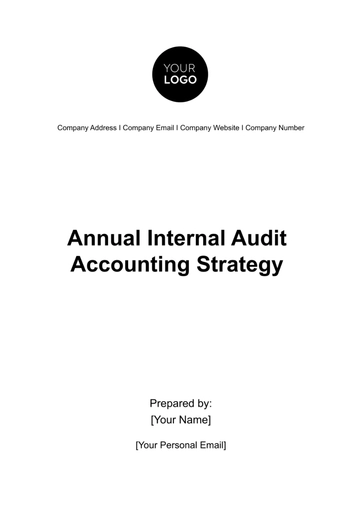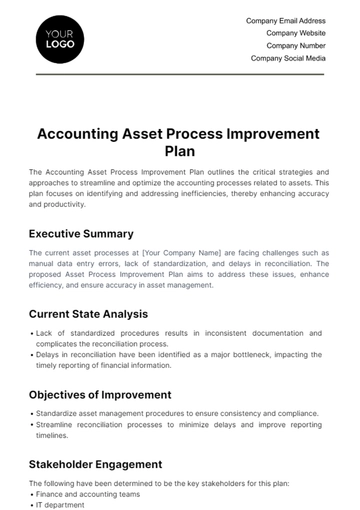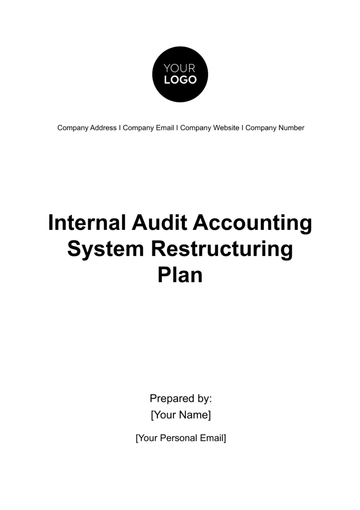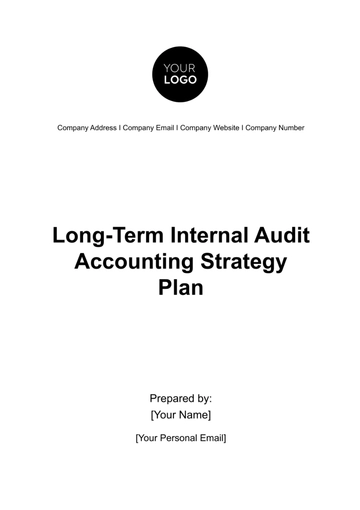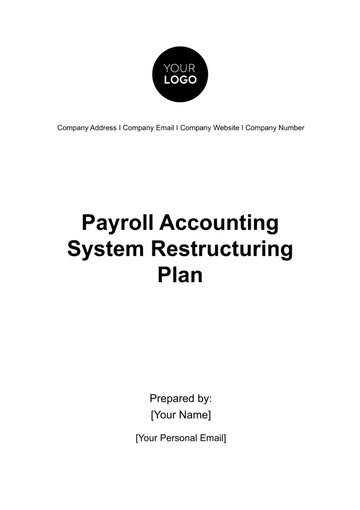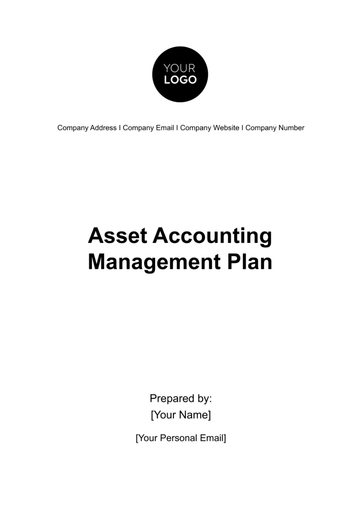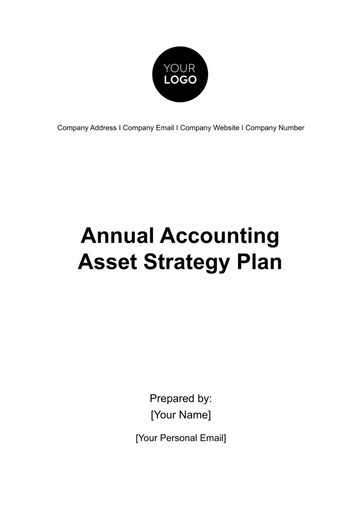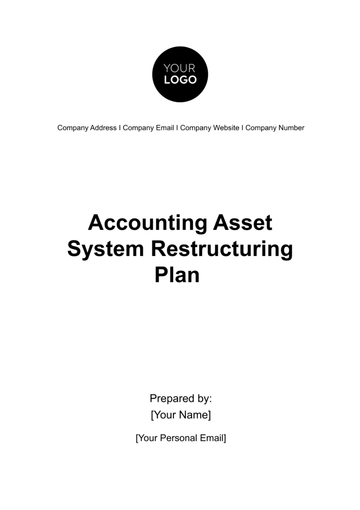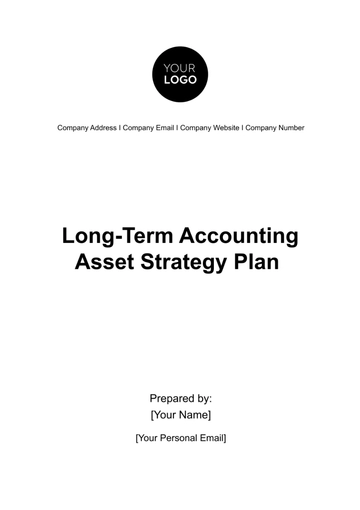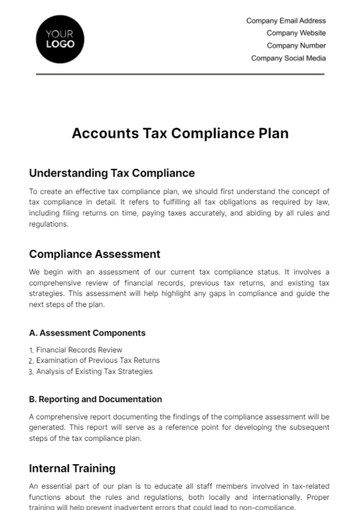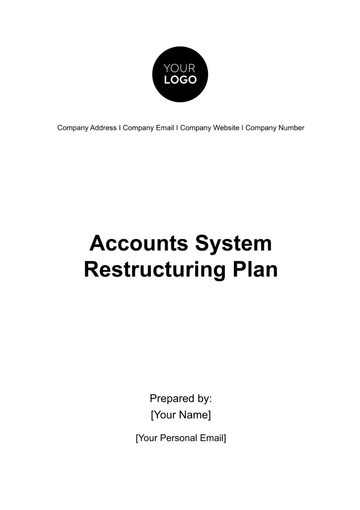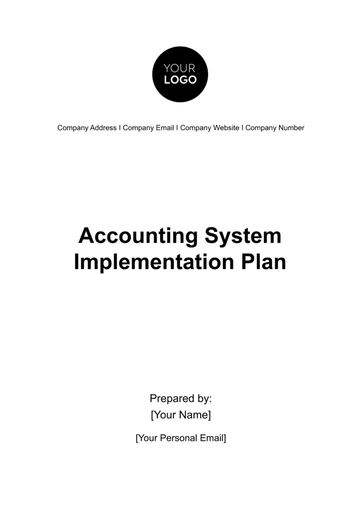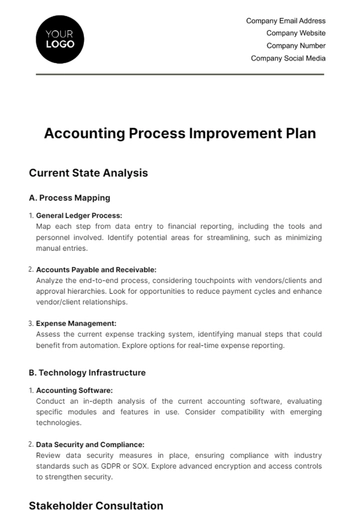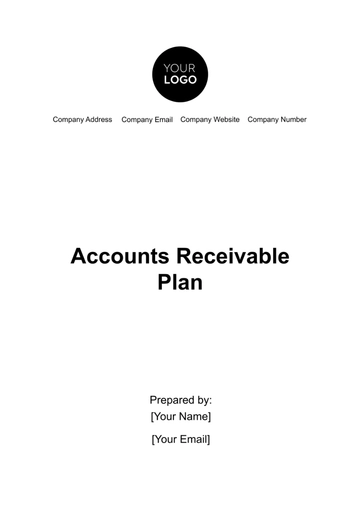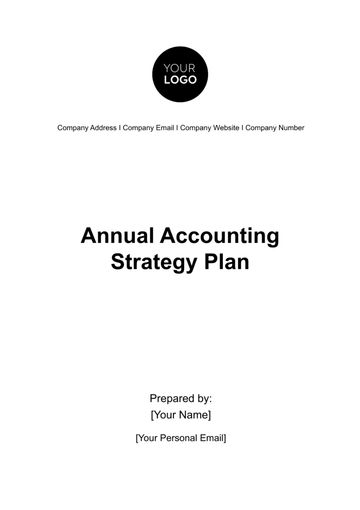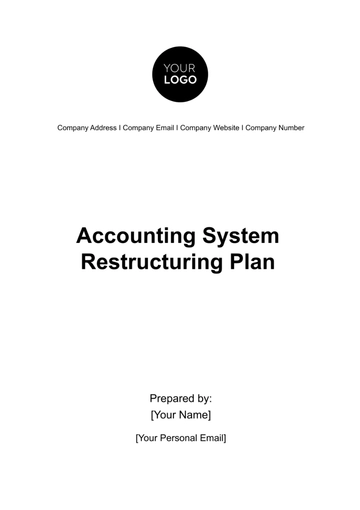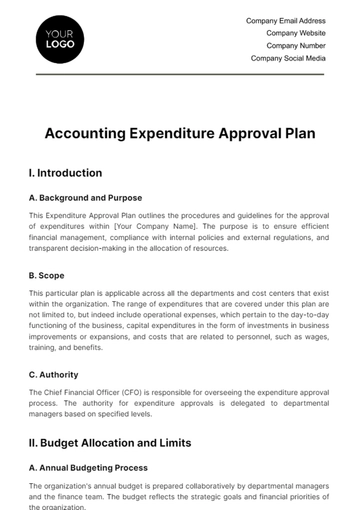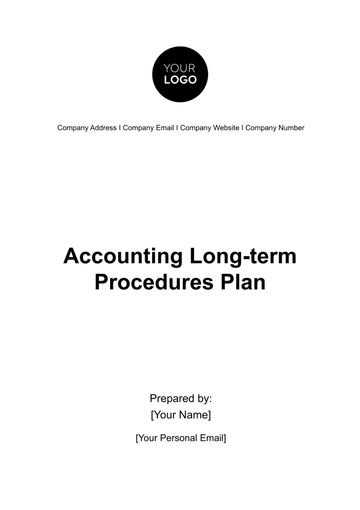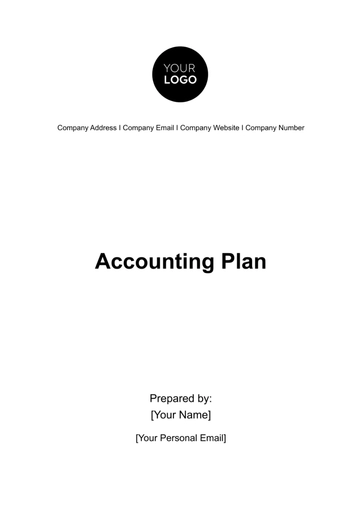Free Finance Accounts Management Plan
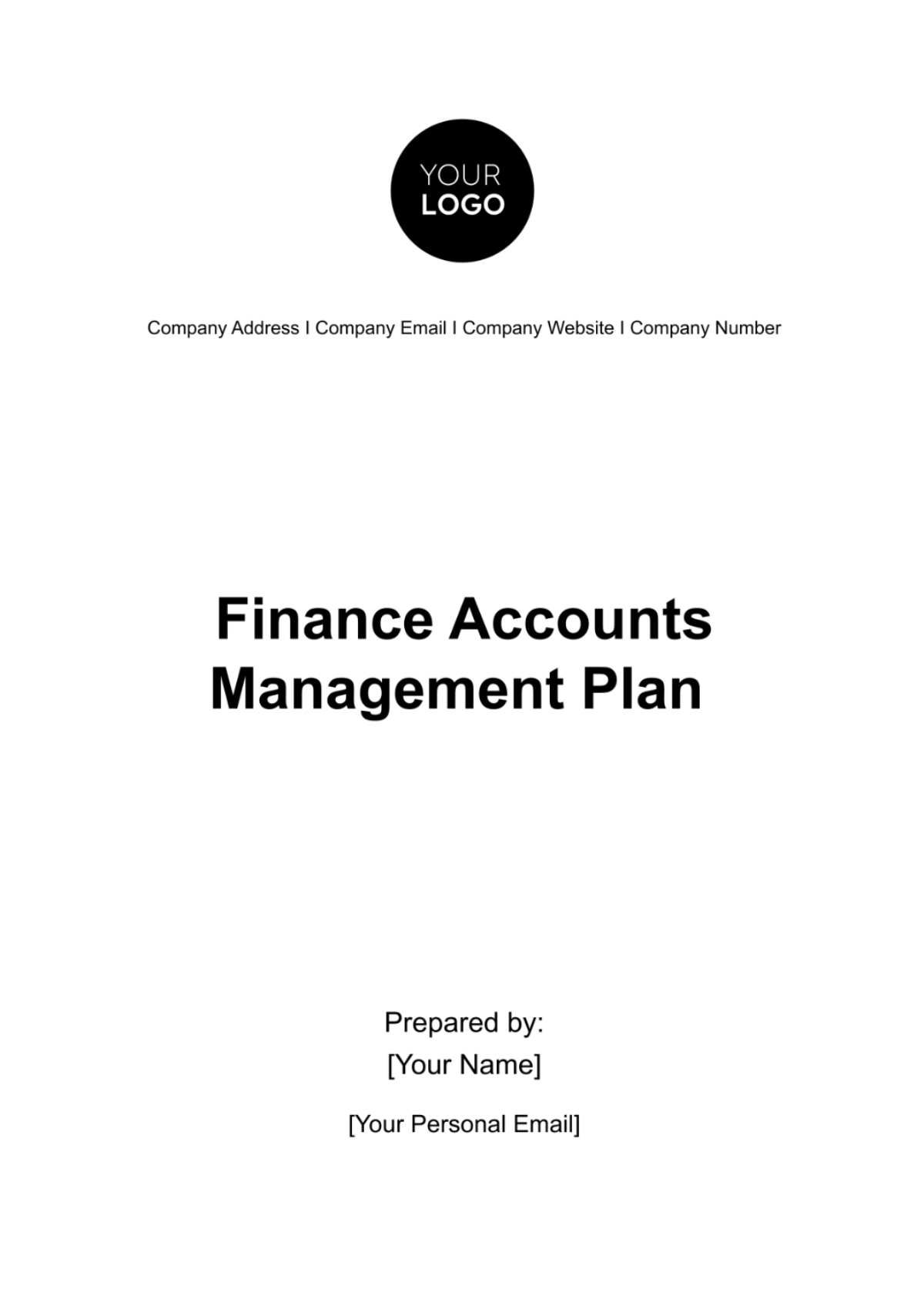
Introduction
Overview
This Finance Accounts Management Plan is crafted to articulate a comprehensive strategy for managing the company's Accounts Payable (AP) and Accounts Receivable (AR). The plan is designed to streamline financial operations, optimize cash flow management, and enhance the efficiency and accuracy of financial reporting. It acknowledges the critical role of effective AP and AR management in maintaining the financial health and sustainability of the organization.
Objectives
The primary objectives of this plan include:
Streamlining AP and AR Processes: Implementing efficient, automated processes to reduce manual intervention, thereby minimizing errors and improving turnaround times.
Improving Financial Reporting Accuracy: Ensuring that all financial transactions are recorded accurately and in a timely manner to provide a reliable basis for financial decision-making.
Optimizing Working Capital: Managing the timing of payments and collections to maintain optimal levels of working capital, thus ensuring the company has sufficient funds for its operations and investments.
Enhancing Vendor and Customer Relationships: Building strong relationships with vendors and customers through timely payments and collections, and clear communication.
Risk Management: Identifying and mitigating financial risks related to credit, fraud, and market changes.
Accounts Receivable Management
Billing Processes
Efficient billing processes are essential for ensuring timely revenue collection and maintaining healthy cash flow. This involves:
Automated Invoice Generation: Utilizing software to automate the generation of invoices immediately upon the completion of services or delivery of goods. This reduces delays and errors associated with manual invoicing.
Customized Billing Options: Offering a variety of billing options to cater to different client needs, such as milestone-based billing, recurring billing for ongoing services, or advance billing for prepaid contracts.
E-Invoicing and Online Payments: Facilitating e-invoicing and online payments to expedite the billing process. This includes options for credit card, direct bank transfers, and digital wallet payments.
Client Billing Portals: Implementing client-specific portals where clients can view their invoice history, outstanding invoices, and make payments directly. This enhances transparency and convenience.
Table: Invoice Processing Time Analysis
Month | Invoices Issued | Average Processing Time (Days) | On-Time Payment Rate (%) |
January | 150 | 2 | 85% |
February | 120 | 3 | 80% |
March | 180 | 1.5 | 90% |
Collections Strategy
A robust collections strategy is essential for maintaining healthy cash flow:
Clear Payment Terms: Establishing and communicating clear payment terms upfront with all customers to set expectations.
Aged Receivables Analysis: Regularly reviewing aged receivables to identify and address overdue accounts promptly.
Proactive Communication: Maintaining proactive communication with customers to address potential payment issues early.
Table: Customer Payment Performance Analysis
Customer | Credit Terms | Average Days to Pay | Total Receivables | Overdue Amount |
[Client Name] | Net 30 | 32 | $20,000 | $5,000 |
[Client Name] | Net 45 | 50 | $15,000 | $3,000 |
Credit Management
Effective credit management minimizes the risk of bad debts and ensures stable cash flow:
Credit Risk Assessment: Implementing a comprehensive credit assessment process for all new and existing customers. This includes analyzing financial statements, credit scores, and market reputation.
Credit Limit Setting: Establishing credit limits based on the creditworthiness assessment. Regularly reviewing these limits based on ongoing payment performance and financial stability of the customer.
Credit Terms Customization: Offering customized credit terms for different customers based on their credit rating, purchase history, and specific needs. This might include shorter credit periods for new or high-risk customers.
Dunning Procedures: Establishing clear procedures for following up on overdue accounts, including reminder emails, phone calls, and potential suspension of services for severely overdue accounts.
Table: Customer Credit Rating and Terms
Customer | Credit Rating | Credit Limit | Standard Credit Terms | Customized Terms Offered |
[Customer] | A (Excellent) | $50,000 | Net 30 | Net 45 with 2% discount |
[Customer] | B (Good) | $30,000 | Net 30 | Net 30 |
[Customer] | C (Fair) | $10,000 | Net 30 | Cash on Delivery |
Regulatory Compliance
Ensuring compliance with all relevant financial regulations is vital:
Compliance Audits: Conducting regular internal audits to ensure compliance with accounting standards and regulatory requirements.
Continual Policy Review: Regularly reviewing and updating financial policies and procedures to align with new regulations and best practices.
Staff Training: Providing ongoing training to finance staff on regulatory changes and compliance requirements.
Technology Integration
Incorporating advanced technology is crucial for optimizing the efficiency and accuracy of financial operations. This section details the specific technologies and practices employed in this integration:
Financial Management Software: Deploying state-of-the-art financial management software that offers comprehensive features such as real-time reporting, integration with banking systems, and automated reconciliation. This software should be scalable to adapt to the company's growing needs.
Data Analytics Tools: Utilizing data analytics tools to analyze financial trends, predict cash flow patterns, and identify areas for cost reduction. These tools help in making informed decisions based on historical data and predictive modeling.
Blockchain for Secure Transactions: Exploring the use of blockchain technology to secure financial transactions, especially in areas prone to fraud. This can include smart contracts for automatic payment processing upon fulfillment of contractual conditions.
Mobile Finance Management: Implementing mobile technology solutions that allow finance teams to access financial data, approve transactions, and perform other essential tasks from anywhere, enhancing flexibility and responsiveness.
Table: Technology Adoption and Impact Analysis
Technology Solution | Implementation Date | Expected Benefits | Performance Metrics |
Financial Management Software | Q2 2050 | Streamlined accounting processes, real-time reporting | 30% reduction in process time |
Data Analytics Tools | Q3 2050 | Improved decision-making, predictive cash flow analysis | 20% increase in forecast accuracy |
Blockchain Implementation | Q4 2050 | Enhanced transaction security, reduced fraud | 50% reduction in fraud incidents |
Mobile Finance Management | Q1 2051 | Increased flexibility, real-time data access | 25% increase in operational efficiency |
Digital Transformation Strategy
The Digital Transformation Strategy is centered around modernizing and streamlining our financial operations through the integration of cutting-edge digital technologies. This transformation aims to enhance efficiency, accuracy, and decision-making capabilities.
Technology Audit and Needs Assessment: Conducting a comprehensive audit of current financial systems and processes to identify areas for digital enhancement. This includes assessing the need for new software, hardware, and skills development among the team.
Integration of AI and Machine Learning: Implementing AI and machine learning technologies for predictive analytics, which can forecast cash flow trends, identify potential financial risks, and suggest optimal investment strategies.
Cloud Computing Adoption: Transitioning to cloud-based financial systems for enhanced data accessibility, scalability, and collaboration. This includes cloud accounting software and secure cloud storage for financial data.
Mobile Technology Utilization: Leveraging mobile technology to allow real-time access to financial information and enable remote working capabilities for the finance team. This includes mobile apps for expense tracking, approvals, and financial reporting.
Cybersecurity Enhancements: Strengthening cybersecurity measures to protect sensitive financial data. This includes regular cybersecurity training for staff, implementing advanced encryption techniques, and adopting secure data transmission protocols.
Table: Digital Transformation Milestones
Milestone | Description | Completion Target | Status |
Cloud-Based System Rollout | Implement a cloud-based accounting system | Q2 2050 | In Progress |
AI Analytics Implementation | Deploy AI for financial forecasting | Q3 2050 | Planned |
Mobile App Development | Develop a mobile app for financial tasks | Q4 2050 | Planned |
Cybersecurity Upgrade | Enhance cybersecurity protocols | Q1 2051 | Not Started |
Staff Training Program | Conduct training on new digital tools | Q2 2051 | Not Started |
Implementation Plan
Phase 1 - Planning and Assessment (Q1-Q2 2024): Conducting a thorough assessment of current systems and developing a detailed implementation plan.
Phase 2 - System Upgrades and Integration (Q3 2024 - Q2 2025): Upgrading existing systems and integrating new digital solutions, including AI analytics and cloud-based systems.
Phase 3 - Training and Transition (Q3 2025): Providing comprehensive training to all team members and transitioning to the new digital platforms.
Phase 4 - Evaluation and Continuous Improvement (Q4 2025 onwards): Regularly evaluating the effectiveness of the digital transformation and making continuous improvements.
Expected Outcomes
Enhanced Efficiency: Streamlined financial processes leading to faster decision-making and reduced operational costs.
Improved Accuracy and Compliance: Greater accuracy in financial reporting and improved compliance with regulatory standards.
Increased Scalability: The ability to easily scale financial operations in line with business growth.
Data-Driven Insights: Access to real-time financial data and insights for better strategic planning.
Conclusion
Summary
This Finance Accounts Management Plan provides a strategic framework to effectively manage the company’s financial operations, particularly focusing on accounts payable and receivable. By emphasizing streamlined processes, technological integration, and robust reporting and compliance, the plan aims to optimize cash flow, enhance financial transparency, and support the overall financial health of the organization.
Future Directions
Looking forward, the plan will adapt to evolving business needs and technological advancements:
Continuous Process Improvement: Regularly assessing and improving financial processes to enhance efficiency and adapt to changing business environments.
Embracing Technological Innovations: Keeping abreast of emerging technologies in finance, such as AI and blockchain, and evaluating their potential integration to further streamline financial operations.
Sustainability and Corporate Responsibility: Integrating principles of sustainability and corporate responsibility into financial practices, aligning with broader organizational goals and societal expectations.
- 100% Customizable, free editor
- Access 1 Million+ Templates, photo’s & graphics
- Download or share as a template
- Click and replace photos, graphics, text, backgrounds
- Resize, crop, AI write & more
- Access advanced editor
Structure your financial strategy with Template.net's Finance Accounts Management Plan Template. This editable, customizable plan outlines approaches for managing financial accounts. Crucial for financial planning, it includes budgeting, forecasting, and resource allocation, ensuring effective control over financial resources and alignment with long-term business objectives.
You may also like
- Finance Plan
- Construction Plan
- Sales Plan
- Development Plan
- Career Plan
- Budget Plan
- HR Plan
- Education Plan
- Transition Plan
- Work Plan
- Training Plan
- Communication Plan
- Operation Plan
- Health And Safety Plan
- Strategy Plan
- Professional Development Plan
- Advertising Plan
- Risk Management Plan
- Restaurant Plan
- School Plan
- Nursing Home Patient Care Plan
- Nursing Care Plan
- Plan Event
- Startup Plan
- Social Media Plan
- Staffing Plan
- Annual Plan
- Content Plan
- Payment Plan
- Implementation Plan
- Hotel Plan
- Workout Plan
- Accounting Plan
- Campaign Plan
- Essay Plan
- 30 60 90 Day Plan
- Research Plan
- Recruitment Plan
- 90 Day Plan
- Quarterly Plan
- Emergency Plan
- 5 Year Plan
- Gym Plan
- Personal Plan
- IT and Software Plan
- Treatment Plan
- Real Estate Plan
- Law Firm Plan
- Healthcare Plan
- Improvement Plan
- Media Plan
- 5 Year Business Plan
- Learning Plan
- Marketing Campaign Plan
- Travel Agency Plan
- Cleaning Services Plan
- Interior Design Plan
- Performance Plan
- PR Plan
- Birth Plan
- Life Plan
- SEO Plan
- Disaster Recovery Plan
- Continuity Plan
- Launch Plan
- Legal Plan
- Behavior Plan
- Performance Improvement Plan
- Salon Plan
- Security Plan
- Security Management Plan
- Employee Development Plan
- Quality Plan
- Service Improvement Plan
- Growth Plan
- Incident Response Plan
- Basketball Plan
- Emergency Action Plan
- Product Launch Plan
- Spa Plan
- Employee Training Plan
- Data Analysis Plan
- Employee Action Plan
- Territory Plan
- Audit Plan
- Classroom Plan
- Activity Plan
- Parenting Plan
- Care Plan
- Project Execution Plan
- Exercise Plan
- Internship Plan
- Software Development Plan
- Continuous Improvement Plan
- Leave Plan
- 90 Day Sales Plan
- Advertising Agency Plan
- Employee Transition Plan
- Smart Action Plan
- Workplace Safety Plan
- Behavior Change Plan
- Contingency Plan
- Continuity of Operations Plan
- Health Plan
- Quality Control Plan
- Self Plan
- Sports Development Plan
- Change Management Plan
- Ecommerce Plan
- Personal Financial Plan
- Process Improvement Plan
- 30-60-90 Day Sales Plan
- Crisis Management Plan
- Engagement Plan
- Execution Plan
- Pandemic Plan
- Quality Assurance Plan
- Service Continuity Plan
- Agile Project Plan
- Fundraising Plan
- Job Transition Plan
- Asset Maintenance Plan
- Maintenance Plan
- Software Test Plan
- Staff Training and Development Plan
- 3 Year Plan
- Brand Activation Plan
- Release Plan
- Resource Plan
- Risk Mitigation Plan
- Teacher Plan
- 30 60 90 Day Plan for New Manager
- Food Safety Plan
- Food Truck Plan
- Hiring Plan
- Quality Management Plan
- Wellness Plan
- Behavior Intervention Plan
- Bonus Plan
- Investment Plan
- Maternity Leave Plan
- Pandemic Response Plan
- Succession Planning
- Coaching Plan
- Configuration Management Plan
- Remote Work Plan
- Self Care Plan
- Teaching Plan
- 100-Day Plan
- HACCP Plan
- Student Plan
- Sustainability Plan
- 30 60 90 Day Plan for Interview
- Access Plan
- Site Specific Safety Plan


